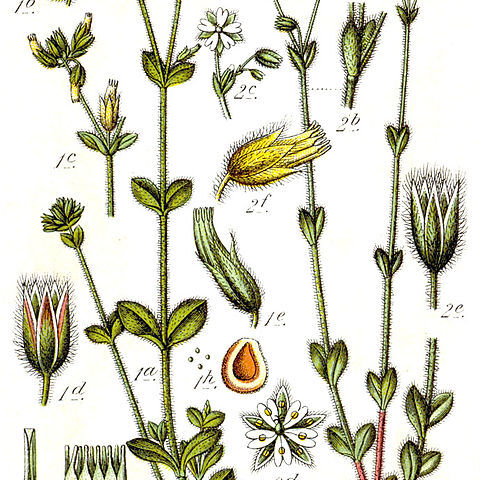Plants perennial, often matted, rhizomatous. Stems prostrate to ascending or erect, usually diffusely branched, sharply 4-angled, (5-)25-50 cm, glabrous to finely papillate, rarely pubescent. Leaves sessile; blade linear-lanceolate to ovate-lanceolate, rarely elliptic-lanceolate, 1-6 cm × 2-8 mm, base cuneate, margins eciliate or scabrid, sometimes ciliate towards base, apex acute. Inflorescences with flowers solitary, terminal and axillary, or terminal, often copious, very lax, leafy cymes; bracts foliaceous, lanceolate, reduced distally to ca. 2 mm, ± scarious. Pedicels erect or patent, usually reflexed at maturity, 10-40 mm, glabrous. Flowers 3-5 mm; sepals 5, 1-3-veined, lanceolate to ovate, 2-5 mm, margins scarious, apex acute, glabrous; petals 5, rarely absent, white or translucent, 1-3 mm, usually shorter than sepals; stamens 5; styles 3, erect to spreading, 0.9-2 mm. Capsules greenish brown or straw colored, ovoid, 3-7 mm, more than 1-1.5 times as long as broad, exceeding sepals, apex acute, opening by 3 valves; carpophore very short or absent. Seeds 10-20, brown, obovate, 0.7-0.9 mm on longest axis, smooth or slightly rugose. 2n = 52.
More
Rhizomatous perennial; stems weak, much-branched, angled, glabrous to scabrous, to 5 dm; lvs lanceolate to lance-linear or oblong, 1–4(–6) cm × 2–8 mm, usually narrowed at the base, the margins often ciliate or scabrous; fls (1–)5–50+ in a lax terminal cyme, the lower bracts herbaceous and often foliaceous, the uppermost often reduced and scarious; pedicels 1–4 cm, erect or arching, seldom reflexed; sep lanceolate, 2–3.5(–4.5) mm in fr; pet shorter than the sep, or usually lacking; styles 1–2 mm, at first erect, later spreading; fr rather firm, ovoid, surpassing the sep, often dark; seeds oblong-obovate, 0.7–0.9 mm, obscurely sculptured; 2n=52. Moist, usually shaded places; Greenl. and Lab. to Alas., s. to N.Y., n. W.Va., Mich., Wis., Minn., Colo., and Oreg. May–Aug. Ours is the widespread var. borealis. (Alsine b.; S. calycantha, misapplied)

